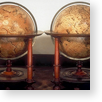
The humanists' interest in Ptolemy's Geography and the discovery of the New World favoured the rapid development of modern cartography thanks to the large production of books, maps and refined globes of all sizes. From the time of Cosimo I, the Medicean collection had contained portolans, precious Ptolemaic codices and a great terrestrial globe over two meters in diameter built by Egnazio Danti (1536-1586). In the 17th century the collection was enriched with splendid globes signed by the most famous European mapmakers - Matthäus Greuter, Adrianus Veen, Jodocus Hondius and Willem Jason Bale.
Unlike maps, which represent the spherical Earth and the sky on two-dimensional surfaces through a geometrically controlled system of distortions, the globe provides a true, non-distorted image of our planet and the universe. Usually made in pairs, terrestrial and celestial, globes were formed of paper segments called gores, glued to a wooden and papier-mâché support. This form of cartographic representation became widespread in the 16th and 17th centuries.
Celestial globe
Inv. 347
Willem Jansz Blaeu, published by Joan Blaeu after 1630
Celestial globe
Loan INAF-Arcetri
Willem Jansz Blaeu, 1622
Celestial globe
Inv. 2696
Jodocus Hondius Jr, Adrianus Veen, 1613
Celestial globe
Inv. 2702
Matthäus Greuter, Rome, 1636
Celestial globe
Inv. 974
Guillaume Delisle, Paris, 1700
Celestial globe
Inv. 3842
John Cary, William Cary, 1816
Celestial globe
Inv. 348
Willem Jansz Blaeu, published by Joan Blaeu after 1630
Celestial globe
Inv. 2697
Willem Jansz Blaeu, published by Joan Blaeu after 1630
Celestial globe
Loan INAF-Arcetri
Maison Delamarche, Paris, after 1805
Celestial globe
Dep. SBAS, Firenze
Johann Georg Klinger, Nuremberg, 1790
Reduction compass
Inv. 655
Maker unknown, 17th cent.
Terrestrial globe
Inv. 353
Willem Jansz Blaeu, published by Joan Blaeu ca. 1645-1648
Terrestrial globe
Inv. 3369
Félix Delamarche & Charles Dien, Paris, 1821
Terrestrial globe
Inv. 354
Willem Jansz Blaeu, published by Joan Blaeu ca. 1645-1648
Terrestrial globe
Inv. 2698
Willem Jansz Blaeu, published by Joan Blaeu ca. 1645-1648
Terrestrial globe
Inv. 3841
John Cary, William Cary, 1816 / after 1818
Terrestrial globe
Dep. SBAS, Firenze
Charles-François Delamarche, Paris, 1785
Terrestrial globe
Inv. 2699
Guillaume Delisle, Paris, 1700 / after 1708
Terrestrial globe
Dep. SBAS, Firenze
Maison Delamarche, Paris, 1850
Terrestrial globe
Dep. SBAS, Firenze
Klinger Kunsthandlung, Nuremberg, ca. 1900
Terrestrial globe
Inv. 3621
Maison Delamarche, Paris, 1858
Terrestrial globe
Loan INAF-Arcetri
Willem Jansz Blaeu, 1622 / published ca. 1630
Terrestrial globe
Inv. 2701
Matthäus Greuter, Rome, 1632
Three-legged compass
Inv. 1480
Maker unknown, Italian, 17th cent.

































